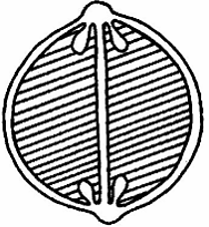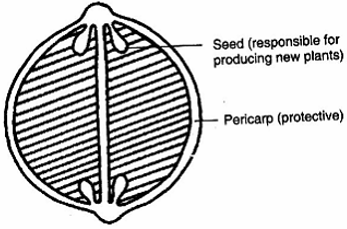Important Questions for Class 12 Biology Repordution in Organisms. myCBSEguide has just released Chapter Wise Question Answers for class 12 Biology. There chapter wise Test papers with complete solutions are available for download in myCBSEguide website and mobile app. These Extra Questions with solution are prepared by our team of expert teachers who are teaching grade in CBSE schools for years. There are around 4-5 set of solved Biology Extra questions from each and every chapter. The students will not miss any concept in these Chapter wise question that are specially designed to tackle Board Exam. We have taken care of every single concept given in CBSE Class 12 Biology syllabus and questions are framed as per the latest marking scheme and blue print issued by CBSE for Class 12.
CBSE Class 12 Biology Ch – 1 Practice Test
Test Paper for Class 12 Biology Reproduction in Organisms
Ch-1 Reproduction in Organisms
- Which of the following is not correct about artificial means of vegetative propagation
- Quick production of new plants
- Economical
- Genetic variation
- Combining good qualities of two different varieties
- Which of the following organism produce gemmules as asexual reproductive structure?
- Hydra
- Sponges
- Penicillium
- Chlamydomonas
- Senescence in most of the animals is not caused by
- Loss of metabolism
- Wear and tear
- Genetic damage
- Lack of Nutrition
- Flagellated, motile asexual reproductive structure are called
-
Megaspores
-
Aplanospores
-
Zoospores
-
Microspores
-
-
The internal buds produced by Spongila is known as
-
Spores
-
Blasts
-
Planula
-
Gemmules
-
-
Explain why meiosis and gametogenesis are always interlinked?
-
Why is the offspring formed by asexual reproduction referred to as clone?
-
Define Parthenogenesis. Given two examples.
-
Why is a whiptail lizard referred to as parthenogenetic.
-
In yeast and Amoeba the parent cell divides to give rise to two new individual cells. How does the cell division differ in these two organisms?
-
Coconut plant is monoecious while date palm is dioecious. Why are they called so?
-
In the following figure of a fruit, label the part which is protective in function and that which is responsible for producing new plants.

-
Describe the post fertilization change in a flower.
-
Differentiate between gametogenesis and embryogenesis.
-
Write a note on sexuality in organisms.
Ch-1 Reproduction in Organisms
Answer
-
- Genetic variation, Explanation: During vegetative propagation, new organisms are formed by single plant parts. So, new individuals are genetically similar to each other and there is no genetic variation.
-
- Sponges, Explanation: Gemmules are asexual reproductive structure produced by sponges. Chlamydomonas produce zoospores, hydra produce buds and Penicillium produces conidia.
-
- Lack of Nutrition, Explanation: Senescence is a natural process followed by maturity of organism. The metabolic processes of organisms start slowing down in this process leading to wear and tear of vital body organ. Nutrition does not affect the process of senescence.
-
- Zoospores, Explanation: A number of simple organism produce single or multi-flagellated spores called zoospores. Water is essential for this mode of reproduction. Aplanospores are non-flagellated spores.
-
- Gemmules, Explanation: Gemmules are internal buds found in sponges and are involved in asexual reproduction. It is an asexually reproduced mass of cells, that is capable of developing into a new organism i.e., an adult sponge
- The gametes produced by gametogenesis are always haploid and it is necessary that meiosis has to occur for the formation of haploid gametes because it is reductional division and ensures half number of chromosomes in the developing gametes.
- The offsprings formed by asexual reproduction are genetically identical to each other, hence are called clone.
- Development of female gamete (ovum) into a complete organism without fertilization is known as parthenogenesis
Examples: Rotifers, Drones of the honey bee. - Because the egg develops into a complete offspring without fertilization.
- In Yeast the cell division is unequal and small buds are produced that remain attached initially to the parent cell. In Amoeba the cell division is equal and produces identical daughter cells.
- Coconut plant produces unisexual male and female flowers on the same plant so it is called monoecious while date palm produces unisexual make and female flowers on separate plants.

- After fertilization, the following changes occur in a flower
– A zygote is formed inside the ovule and develops into the embryo.
– The ovules develop into the seed.
– The ovary develops into the fruit.
– Ovary wall is transformed into a protective layer, pericarp. -
Gametogenesis Embryogenesis 1. It is the process of generation of haploid gametes. 1. It is the process of formation of embryo. 2. It involves meiosis. 2. It involves mitosis. 3. Further transformation may be required to make male gametes motile 3. Further cell differentiation required for the formation of specialised tissues and organs. - Sexual reproduction in organisms generally involves the fusion of male and female gametes. Sexuality in plants and animals can be of different types.
Sexuality in plants: Plants may have both male and female reproductive structures in the same individual. Such plants are known as bisexual plants. For example, Rose, coconut. While there are some plants which have male and female reproductive structures separately on the different individuals and are known as unisexual plants. For example, papaya, date and palm. In the case of several fungi and plants, homothallic and monoecious terms are used to denote the bisexual condition while the unisexual condition is described using terms like heterothallic and dioecious.
The flowering plants bearing only stamens are called staminate plants, while the one bearing only female flowers are called pistillate plants. The flowering plants having both male and female flowers present on the same individual are known as monoecious plants like cucurbits while the one with male and female flowers on different individuals are known as dioecious plants like mulberry and, date palm.
Sexuality in animals: In a few animal species, a single individual may possess both male and female reproductive organs and is known as bisexual or hermaphrodite. For example, Earthworms, sponge, tapeworm, and leech. There are other animal species which have either male or female reproductive organ in an individual and are called as unisexual organisms. For example, Frog, lizard, crow, dog, cat, rabbit, human beings, etc.
Class 12 Biology Chapter Wise Test Paper
- Reproduction in Organisms
- Sexual Reproduction in Flowering Plants
- Human Reproduction
- Reproductive Health
- Principles of Inheritance and Variation
- Molecular Basis of Inheritance
- Evolution
- Human Health and Disease
- Strategies for Enhancement in Food Production
- Microbes in Human Welfare
- Biotechnology Principles and Processes
- Biotechnology and its Applications
- Organisms and Populations
- Ecosystem
- Biodiversity and Conservation
- Environmental Issues

Test Generator
Create question paper PDF and online tests with your own name & logo in minutes.
Create Now
Learn8 App
Practice unlimited questions for Entrance tests & government job exams at ₹99 only
Install Now